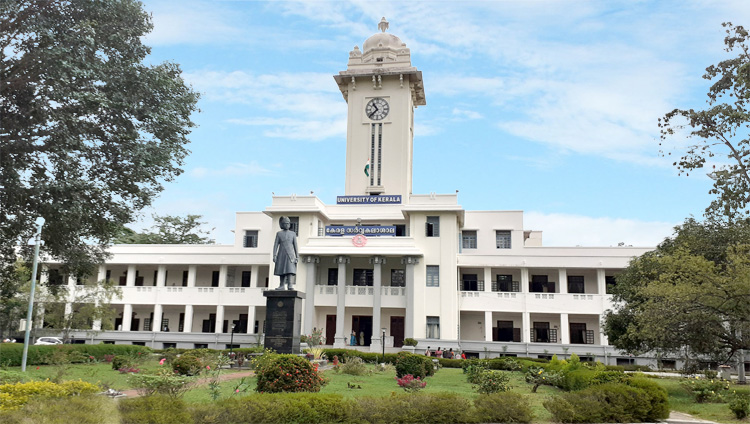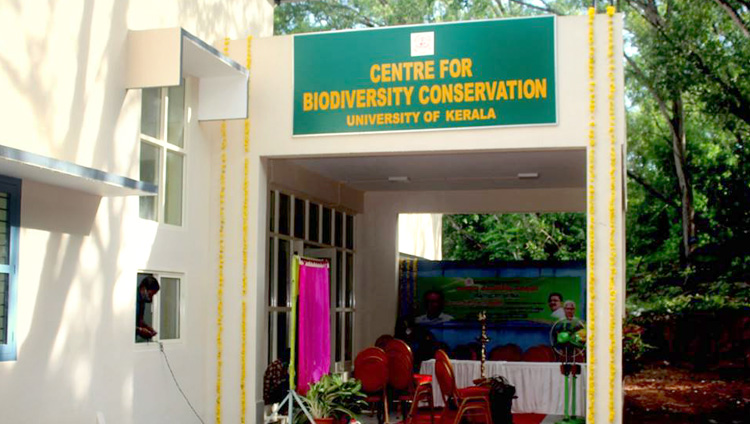Welcome to the Digital Garden of University of Kerala

University of Kerala is one of the first 16 Universities in India, founded as the University of Travancore in the erstwhile princely state of Travancore in 1937. Since then, the University of Kerala has transformed itself in many ways. University of Kerala is today known as the “Mother University” of the state, as almost all the other Universities in the state were created by either bifurcating it or re-affiliating its affiliated colleges.
The University of Kerala has two major campuses, the largest being the Kariavattom campus, 16Km from the city centre. Geographically Palayam lays 8 30’16 N latitude and 76 57’01 E longitude. The Palayam/Senate Hall Campus [17 acres] is right in the middle of the city; possess 6 departments. The Palayam campus has mainly the administrative office of the University, including the Vice-Chancellor’s and Registrar’s office. In addition to the office of Controller of Examinations and Computer Centre, the Palayam Campus also houses the departments of English,German and Russian, and the School of Distance Education, Students Amenities Centre.
Thirty Six departments are situated in the Karyavattom Campus. This sprawling green campus [359 acres] is close to Kazhakuttom, on the National Highway 66. Kariavattom campus situated at the north east of Thiruvananthapuram city and 3 km near the Arabian sea. Geographically Kariavattom lays 8 34’6 N latitude and 76 52’51 E longitude at an altitude of 60 m above Sea level. The typical tropical climate prevailed over witha mean rain fall of 1850 mm. Texturally the soil of the study site has been classified as lateritic soil.
The present study involves the documentation and QR code enabled digitization of tree species of Kariavattom and Palayam Campus of University of Kerala.
Digitization of Flora through QR Code


Digital Garden is a concept of digitization of floristic diversity of an area for the easy access of plant data using our mobile phones. The concept of digital garden and creation of India’s first digital garden was done by Shri Akhilesh S. V. Nair, Research Scholar, Department of Botany, University of Kerala, and Dr. A. Gangaprasad, Professor, Hon. Director, Centre for Biodiversity Conservation, Department of Botany, University of Kerala, at Kanakakkunnu Palace, Thiruvananthapuram. After the success of establishing the digital garden at Kanakakkunnu Palace, Thiruvananthapuram, the authors also established a digital garden at Kerala Raj Bhavan, Kerala Niyamasabha (Kerala Legislative Assembly), University of Kerala, Kerala Public Service Commission, Maharaja’s College Ernakulam.
Documented data were digitized through website creation and QR (Quick Response) code linking. Specific URLs were used to create QR codes for each species. In order to create a digital garden, the QR code is placed along with the plant label. By scanning the QR code with a QR code scanner in the mobile phone, the code translates the URL and open to the website, where the person can access the complete data of each plant species.
Digital garden at university was officially inaugurated by Hon. Vice Chancellor of University of Kerala, Prof (Dr) V. P. Mahadevan Pillai; in the presence of Pro Vice Chancellor, Registrar and Syndicate members.More than 250 species of trees were documented in the Palayam senate house and Kariavattom campus. In the documentation, tall shrubs have also been included. All the documented data were digitized through website creation; QR code linking. By digitizing the information of the plants in the University of Kerala, visitors can learn more about our biological diversity. Any person who are interested in Plants can assess the website freely – https://www.keralauniversity.ac.in/digital_garden/home . Through this project University of Kerala becomes the India’s First University with digital garden.
Centre for Biodiversity Conservation, University of Kerala

Implementation of digital garden in University of Kerala campuses was undertaken by the Centre for Biodiversity Conservation, University of Kerala. Centre for Biodiversity Conservation was established to provide bounteous knowledge about the importance of conservation of our biodiversity to the upcoming young talents. Centre for Biodiversity Conservation is currently involved in the conservation and sustainable utilization of both wild ornamental and edible plants of Western Ghats, and Digital Gardening. The Centre also proposes to establish an orchard of fruit trees in place of the existing Acacia plantation by planting the locally available traditional varieties of fruit trees collected from various parts of Kerala. As a first step, it is proposed to establish an orchard in acres of land in and around the Hymavathi Pond at Kariavattom campus, University of Kerala. Centre is also involved in the conservation of economically important species of Andaman and Nicobar Islands. Recently, more than hundred species of such plants were collected from Andaman Islands for the establishment of an ex-situ Gene Bank of economically important species in the Kariavattom campus.



 Home
Home